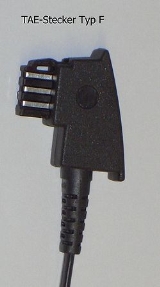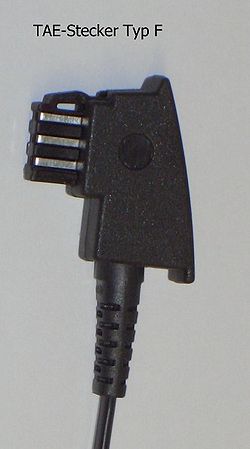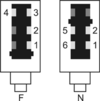
TAE connector
Encyclopedia
TAE is the German
standard for telephone plugs and sockets.
 The standard covers two TAE types: F ("Fernsprechgerät": for telephones) and N ("Nebengerät" or "Nichtfernsprechgerät": for other devices such as answering machines and modems). U coded sockets and plugs are universal connectors that are suitable for both device types.
The standard covers two TAE types: F ("Fernsprechgerät": for telephones) and N ("Nebengerät" or "Nichtfernsprechgerät": for other devices such as answering machines and modems). U coded sockets and plugs are universal connectors that are suitable for both device types.
E-coded connectors that are used in EAD-socket
s are not intended for telephony applications.
(DBP, German Federal Post) was divided into Deutsche Post
(postal service), Deutsche Telekom
(telecommunication services) and Postbank
(financial services). Previously, the older ADo type connectors had been used, or telephones had been hardwired to their (VDo) wall sockets, and only officially approved telephones (legally distributable only by the DBP) were allowed to be connected to the telephone system. Furthermore, telephones and other communication devices could only be leased from the DBP and not be sold or bought on the free market.
By introduction of the TAE system the legal specification claiming that communication terminal equipment should be in the responsibility of the users could be implemented. Subsequently, a wide palette of communication devices became available in the open market for being plugged in standard TAE sockets. Adaptors allow for connecting devices with registered jack
s that are internationally more prevalent.
Today, TAE connectors are common in Germany
and other central European countries like Liechtenstein
and Luxembourg
. Modern TAE sockets also contain circuits referred to as "passiver Prüfabschluss" (network terminator analog).
 Typical TAE installation is a multi-socket junction box with at least one N connector and one F connector socket in the box (usually 2 N and one F connector, but up to 3 N connectors are possible). Network service enters the box and connects to pins 1 and 2 on the right-most N connector. Service is daisy-chained from pins 5 and 6 on the N connector to pins 1 and 2 on the next N connector to the left. The F connector is attached to pins 5 and 6 on the last N connector at the end of the chain.
Typical TAE installation is a multi-socket junction box with at least one N connector and one F connector socket in the box (usually 2 N and one F connector, but up to 3 N connectors are possible). Network service enters the box and connects to pins 1 and 2 on the right-most N connector. Service is daisy-chained from pins 5 and 6 on the N connector to pins 1 and 2 on the next N connector to the left. The F connector is attached to pins 5 and 6 on the last N connector at the end of the chain.
 (Image shown with flat side of connector down and the metallic pins facing you. The cable pigtail exits at the bottom of the connector)
(Image shown with flat side of connector down and the metallic pins facing you. The cable pigtail exits at the bottom of the connector)
If you are wiring a TAE plug, note that you should use a MIRROR IMAGE of this illustration (pins 1 through 3 are on the LEFT side) if wiring the connector with the flat side UP.
The TAE connector's form factor is more clumsy than the registered jack
connector.
Germany
Germany , officially the Federal Republic of Germany , is a federal parliamentary republic in Europe. The country consists of 16 states while the capital and largest city is Berlin. Germany covers an area of 357,021 km2 and has a largely temperate seasonal climate...
standard for telephone plugs and sockets.

E-coded connectors that are used in EAD-socket
EAD-socket
EAD is an abbreviation for German Ethernet-Anschlussdose. The EAD standard defines wall mounted Ethernet connection outlets that enjoy a higher reliability than standard BNC T-connectors....
s are not intended for telephony applications.
History
The TAE system was introduced in the late 1980s before the German government-owned institution Deutsche BundespostDeutsche Bundespost
The Deutsche Bundespost was created in 1947 as a successor to the Reichspost . Between 1947 and 1950 the enterprise was called Deutsche Post...
(DBP, German Federal Post) was divided into Deutsche Post
Deutsche Post
Deutsche Post AG, operating under the trade name Deutsche Post DHL, is the world's largest logistics group. With its headquarters in Bonn, the corporation has 467,088 employees in more than 220 countries and territories worldwide and generated revenue of € 51.48 billion in 2010...
(postal service), Deutsche Telekom
Deutsche Telekom
Deutsche Telekom AG is a telecommunications company headquartered in Bonn, Germany. It is the largest telecommunications company in Europe....
(telecommunication services) and Postbank
Postbank
Postbank may refer to any of the postal savings systems in these countries:* Deutsche Postbank* Postbank N.V.* Postbank, a Bulgarian bank owned by Eurobank EFG* PostBank, a savings bank that operated in New Zealand...
(financial services). Previously, the older ADo type connectors had been used, or telephones had been hardwired to their (VDo) wall sockets, and only officially approved telephones (legally distributable only by the DBP) were allowed to be connected to the telephone system. Furthermore, telephones and other communication devices could only be leased from the DBP and not be sold or bought on the free market.
By introduction of the TAE system the legal specification claiming that communication terminal equipment should be in the responsibility of the users could be implemented. Subsequently, a wide palette of communication devices became available in the open market for being plugged in standard TAE sockets. Adaptors allow for connecting devices with registered jack
Registered jack
A registered jack is a standardized physical network interface — both jack construction and wiring pattern — for connecting telecommunications or data equipment to a service provided by a local exchange carrier or long distance carrier. The standard designs for these connectors and their wiring...
s that are internationally more prevalent.
Today, TAE connectors are common in Germany
Germany
Germany , officially the Federal Republic of Germany , is a federal parliamentary republic in Europe. The country consists of 16 states while the capital and largest city is Berlin. Germany covers an area of 357,021 km2 and has a largely temperate seasonal climate...
and other central European countries like Liechtenstein
Liechtenstein
The Principality of Liechtenstein is a doubly landlocked alpine country in Central Europe, bordered by Switzerland to the west and south and by Austria to the east. Its area is just over , and it has an estimated population of 35,000. Its capital is Vaduz. The biggest town is Schaan...
and Luxembourg
Luxembourg
Luxembourg , officially the Grand Duchy of Luxembourg , is a landlocked country in western Europe, bordered by Belgium, France, and Germany. It has two principal regions: the Oesling in the North as part of the Ardennes massif, and the Gutland in the south...
. Modern TAE sockets also contain circuits referred to as "passiver Prüfabschluss" (network terminator analog).
TAE socket

TAE plug

If you are wiring a TAE plug, note that you should use a MIRROR IMAGE of this illustration (pins 1 through 3 are on the LEFT side) if wiring the connector with the flat side UP.
Criticism
As the TAE connector does not have gold contacts the contacts may oxidize, which can cause sizzling and crackling noises in analog voice transmission.The TAE connector's form factor is more clumsy than the registered jack
Registered jack
A registered jack is a standardized physical network interface — both jack construction and wiring pattern — for connecting telecommunications or data equipment to a service provided by a local exchange carrier or long distance carrier. The standard designs for these connectors and their wiring...
connector.
Pin-out
| Pin | Name | Used for | Color of the wire |
| 1 | La | Exchange line a | White |
| 2 | Lb | Exchange line b | Brown |
| 3 | W | Line for external bell (obsolete since mid-1990s) | Green |
| 4 | E | Line for ground connection, used to request an external connection in very old telephone installations | Yellow |
| 5 | a2 | Line b, looped through the telecommunication device | Pink |
| 6 | b2 | Line a, looped through the telecommunication device | Gray |

